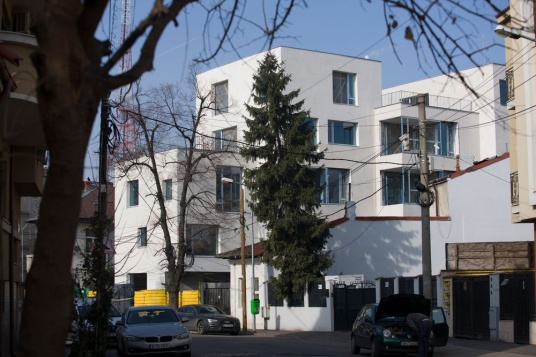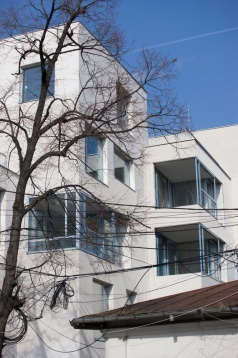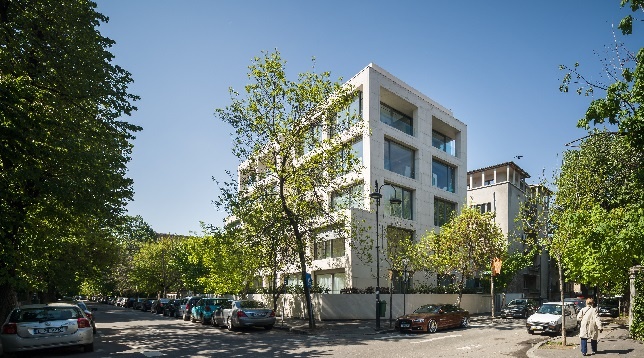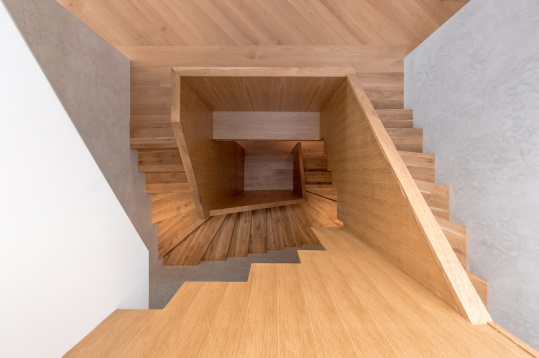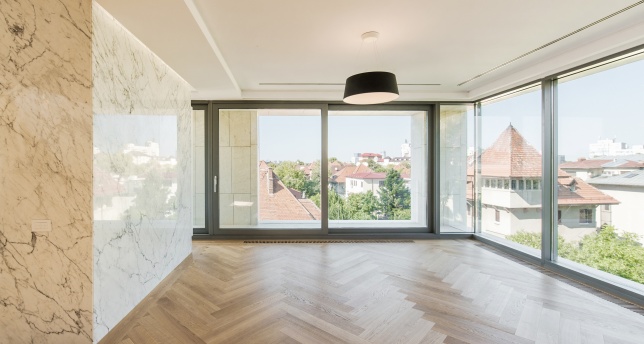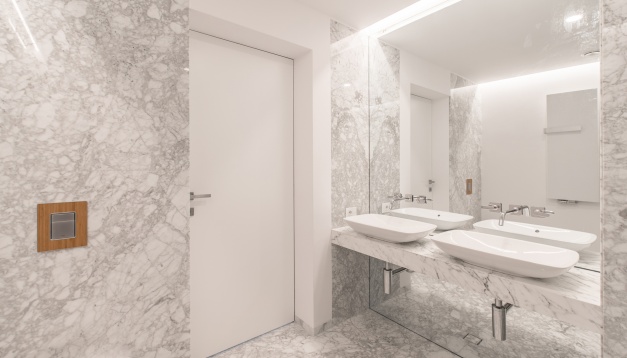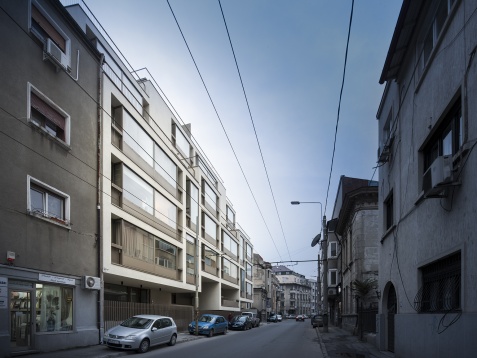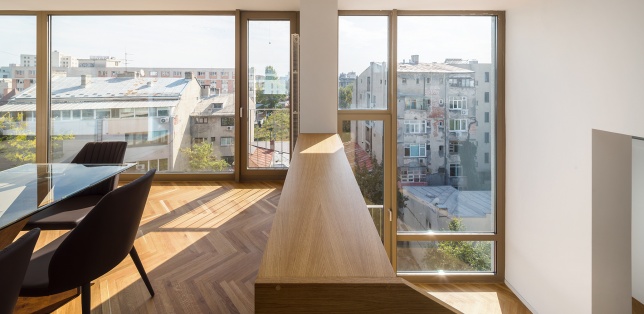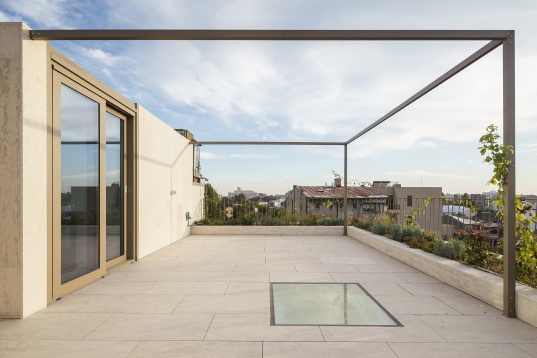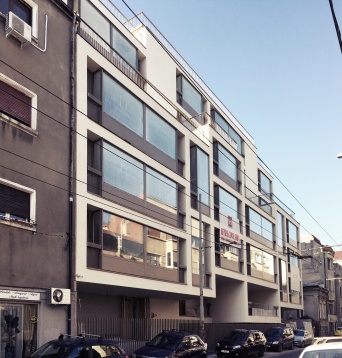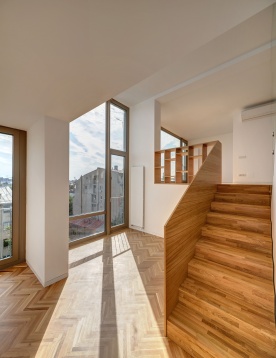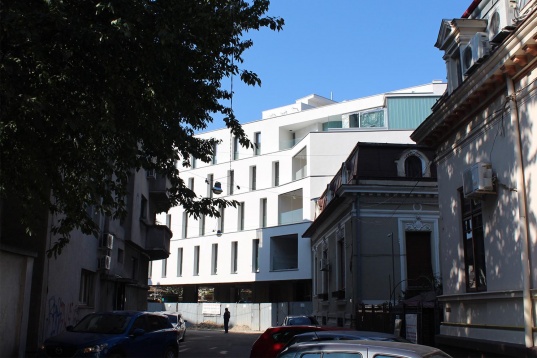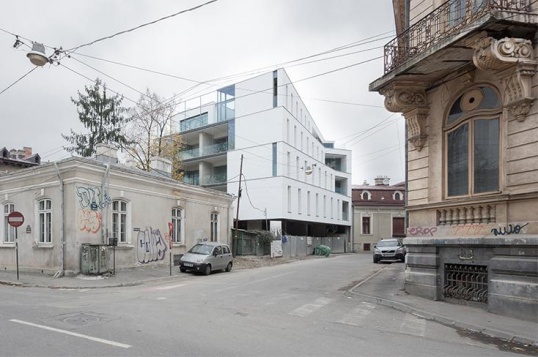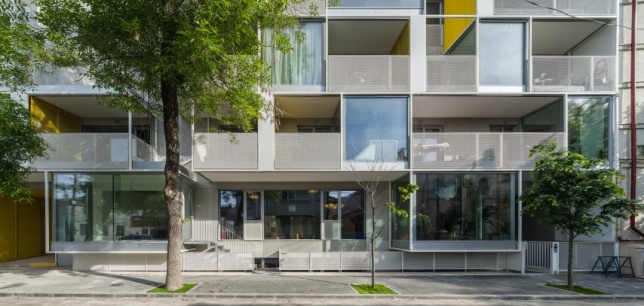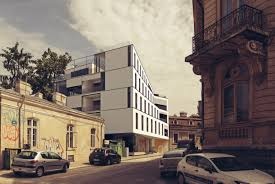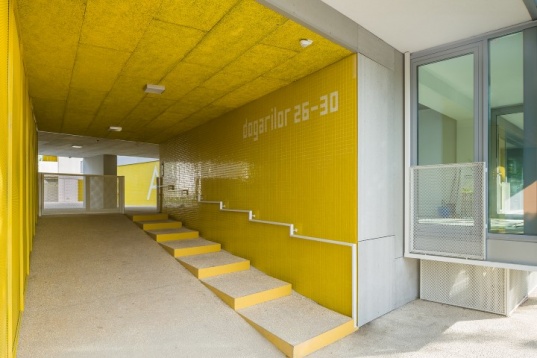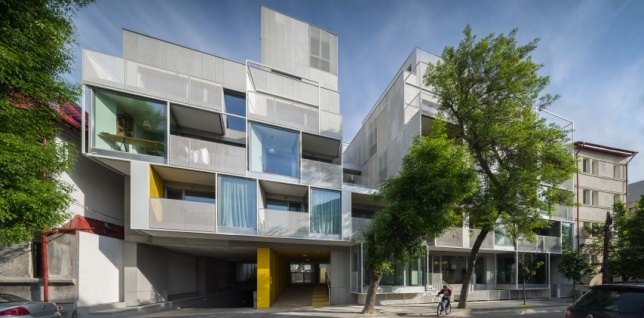HISTORY
ADNBA was established in 2003 in Bucharest, by Andrei Șerbescu and Adrian Untaru, later joined by Bogdan Brădățeanu. Currently belonging to a diverse body of work, all of the projects developed in the studio strive for a wider and wise understanding of the city and its evolution, as the essential background for thoughts, hopes and doubts.
SPECIFIC
The work of the office is characterised by the attempt to search for the right balance between experi-ment and experience in the complex and delicate landscape of contemporary life. ADNBA believes in architecture as a creative gesture, with cultural value and social responsibility, admiting the sometimes hazardous, and always subjective distinction between such attributes, in a rapidly changing environment as in Romania and the whole of Eastern Europe.
ROMANIAN DESIGN WEEK APPEARANCES
2019 // 'URBAN SPACES 2'/ Mumuleanu Housing
Specific to some Bucharest courtyards where houses that share a common yard are attached one to another, seven larger homes are placed along a deep courtyard with a broken, imprecise contour, opened less to the street and more to that obscure core which hides very often among the streets of the city. Furthermore, these houses contain within other houses which are overlapped and adjacent, with distinct entrances, porches, gardens and terraces or just niches towards either the western front entrance courtyard or the more intimate eastern courtyard to the back. In between these two narrow courtyards lay all the dwellings with private spaces connected to both of them, which allow the morning and afternoon sunlight to reach in through their open doors and windows, thus, each home becomes accustomed to its orientation and vicinity. Probably, the future residents will get acquainted with each other in a similar manner.
2018 // Londra
Space - structure provides weight for the urban presence of our proposal, acting as a counterbalance for the large openings, in an attempt to equal the opposite front. The withdrawal of the central span and the cornice’s asymmetry breaks the volume in two in order to get closer to the scale of the neighbouring builldings.
Windows and deep loggias could be read as substractions from the massive stone volume. The structure of the house dematerializes verticaly - floors successively withdraw and windows increase, the side structure walls being perforated to the limit of their resistance. The gravitational force is transmitted in a continuous structural system and the facade is expressing this logic through stone stereotomy.
Lateral spans are for housing, while the central one accommodates the staircase.The 7 apartments boast spectacular urban views, becoming part of the interior spaces, while indwelling lets itself glimsed from the street.
2018 // Occidentului Housing
Working from the inside out
Occidentului Street is a typical street for the central area of Bucharest, with isolated villas in the middle of the yard, wagon-houses, buildings from the interwar period and insertions from the ‘60s and ‘70s. The general volume is decomposed through several movements and set-backs into a row of smaller houses with different heights that sequence the perception of the building and nuances the relationship to the neighboring houses and the fragmentary surroundings.
The intervention proposes a community of 20 apartments and a commercial unit on the wide but relatively shallow plot. All units are transversal / double oriented and organized on split-levels. Instead of typical stacked general floors, here the floors and ceilings move and generate a series of staggered floors, level differences and variations in height and depth – lending the apartments something of the vertical dimension of dwelling.
2016 // AARON FLORIAN APARTMENT BUILDING
The retracted plinth gives the building a lightsome, almost detached appearance, connected to the ground only by the tectonic effect of the stairs leading into the building. The transparency of the ground floor allows for comercial or office spaces to open themselves to the street, thus livening this rather narrow and trafficless blind alley.
Floors 1 to 3 comprise three apartments each, while the last floor contains two larger apartments with terraces both at their level and on the rooftop, that provide spectacular views of one of the most beautiful neighbourhoods in Bucharest.
ADNBA was established in 2003 in Bucharest, by Andrei Șerbescu and Adrian Untaru, later joined by Bogdan Brădățeanu. Currently belonging to a diverse body of work, all of the projects developed in the studio strive for a wider and wise understanding of the city and its evolution, as the essential background for thoughts, hopes and doubts.
SPECIFIC
The work of the office is characterised by the attempt to search for the right balance between experi-ment and experience in the complex and delicate landscape of contemporary life. ADNBA believes in architecture as a creative gesture, with cultural value and social responsibility, admiting the sometimes hazardous, and always subjective distinction between such attributes, in a rapidly changing environment as in Romania and the whole of Eastern Europe.
ROMANIAN DESIGN WEEK APPEARANCES
2019 // 'URBAN SPACES 2'/ Mumuleanu Housing
Specific to some Bucharest courtyards where houses that share a common yard are attached one to another, seven larger homes are placed along a deep courtyard with a broken, imprecise contour, opened less to the street and more to that obscure core which hides very often among the streets of the city. Furthermore, these houses contain within other houses which are overlapped and adjacent, with distinct entrances, porches, gardens and terraces or just niches towards either the western front entrance courtyard or the more intimate eastern courtyard to the back. In between these two narrow courtyards lay all the dwellings with private spaces connected to both of them, which allow the morning and afternoon sunlight to reach in through their open doors and windows, thus, each home becomes accustomed to its orientation and vicinity. Probably, the future residents will get acquainted with each other in a similar manner.
2018 // Londra
Space - structure provides weight for the urban presence of our proposal, acting as a counterbalance for the large openings, in an attempt to equal the opposite front. The withdrawal of the central span and the cornice’s asymmetry breaks the volume in two in order to get closer to the scale of the neighbouring builldings.
Windows and deep loggias could be read as substractions from the massive stone volume. The structure of the house dematerializes verticaly - floors successively withdraw and windows increase, the side structure walls being perforated to the limit of their resistance. The gravitational force is transmitted in a continuous structural system and the facade is expressing this logic through stone stereotomy.
Lateral spans are for housing, while the central one accommodates the staircase.The 7 apartments boast spectacular urban views, becoming part of the interior spaces, while indwelling lets itself glimsed from the street.
2018 // Occidentului Housing
Working from the inside out
Occidentului Street is a typical street for the central area of Bucharest, with isolated villas in the middle of the yard, wagon-houses, buildings from the interwar period and insertions from the ‘60s and ‘70s. The general volume is decomposed through several movements and set-backs into a row of smaller houses with different heights that sequence the perception of the building and nuances the relationship to the neighboring houses and the fragmentary surroundings.
The intervention proposes a community of 20 apartments and a commercial unit on the wide but relatively shallow plot. All units are transversal / double oriented and organized on split-levels. Instead of typical stacked general floors, here the floors and ceilings move and generate a series of staggered floors, level differences and variations in height and depth – lending the apartments something of the vertical dimension of dwelling.
2016 // AARON FLORIAN APARTMENT BUILDING
One of the first housing projects of the office, the Aaron Florian Apartment Building, completed only mid last year, is an honest answer to a particular urban setting: an irregular plot, the closeness of the opposite building raising privacy issues, a blind wall to a difficult neighbour and an inflection of the street. All these produce an atypical configuration - a building with floors successively recessed, the upper floors providing more light to the narrow street and the exterior spaces directing the views along it.
The retracted plinth gives the building a lightsome, almost detached appearance, connected to the ground only by the tectonic effect of the stairs leading into the building. The transparency of the ground floor allows for comercial or office spaces to open themselves to the street, thus livening this rather narrow and trafficless blind alley.
Floors 1 to 3 comprise three apartments each, while the last floor contains two larger apartments with terraces both at their level and on the rooftop, that provide spectacular views of one of the most beautiful neighbourhoods in Bucharest.
2015 // 'Urban Spaces' / Dogarilor Apartment Building
One of the most important and problematic aspects of nowadays Bucharest is the fast densification of the central area. While we believe that density can, and many times must be seen as a form of sustainability, we also admit that the often fragile relationship between habitation within an old neighborhood and the increase of density could many times alter the place and reduce its existing qualities.
Our project is looking for an appropriate answer to this problem. It tries to mediate between different sizes and densities, in a quite central neighborhood characterized by small streets, long, narrow plots and a puzzle of old and new buildings of all types and scales. The building searches to preserve, at its own scale, the porosity and "profoundness" of the deep, narrow plots, while also trying to capture part of the "collage"-like appearance of the surroundings. The volumetric proposal seeks to partially open the building to the street, in the depth of the plot. Because of this, the volume facing the street is less compact and the ground floor is more transparent, in order to allow a better visual connection at eye's level. In this way, we have also tried to mediate between the continuous alignment required by the urban regulation and the specific of the street and of the surrounding urban fabric, characterized by fragmentation.
At the same time, the project proposes a type of habitation which we consider suitable for the center of the contemporary city: a place where the relatively small spaces and the density are complemented by diversity and wider common spaces. Most of the apartments are different from one another, not only in size, but especially in typology: they range from studios to four-bedroom apartments - each one of them laying on one, two or even three floors and having private courtyards, balconies or terraces of different sizes.
They all are complemented by several indoor and outdoor common spaces (terraces, party room, large halls etc.), while the ground floor offers several commercial spaces and ateliers to rent, towards the street and the inner courtyard. The apartments are conceived in such way as to allow a great deal of flexibility, making it possible to connect (horizontally or vertically) two or more small units into a larger one, leading, in the end, at a building consisting of 77 residential units offering approx. 50 types of apartments.
One of the most important and problematic aspects of nowadays Bucharest is the fast densification of the central area. While we believe that density can, and many times must be seen as a form of sustainability, we also admit that the often fragile relationship between habitation within an old neighborhood and the increase of density could many times alter the place and reduce its existing qualities.
Our project is looking for an appropriate answer to this problem. It tries to mediate between different sizes and densities, in a quite central neighborhood characterized by small streets, long, narrow plots and a puzzle of old and new buildings of all types and scales. The building searches to preserve, at its own scale, the porosity and "profoundness" of the deep, narrow plots, while also trying to capture part of the "collage"-like appearance of the surroundings. The volumetric proposal seeks to partially open the building to the street, in the depth of the plot. Because of this, the volume facing the street is less compact and the ground floor is more transparent, in order to allow a better visual connection at eye's level. In this way, we have also tried to mediate between the continuous alignment required by the urban regulation and the specific of the street and of the surrounding urban fabric, characterized by fragmentation.
At the same time, the project proposes a type of habitation which we consider suitable for the center of the contemporary city: a place where the relatively small spaces and the density are complemented by diversity and wider common spaces. Most of the apartments are different from one another, not only in size, but especially in typology: they range from studios to four-bedroom apartments - each one of them laying on one, two or even three floors and having private courtyards, balconies or terraces of different sizes.
They all are complemented by several indoor and outdoor common spaces (terraces, party room, large halls etc.), while the ground floor offers several commercial spaces and ateliers to rent, towards the street and the inner courtyard. The apartments are conceived in such way as to allow a great deal of flexibility, making it possible to connect (horizontally or vertically) two or more small units into a larger one, leading, in the end, at a building consisting of 77 residential units offering approx. 50 types of apartments.
















